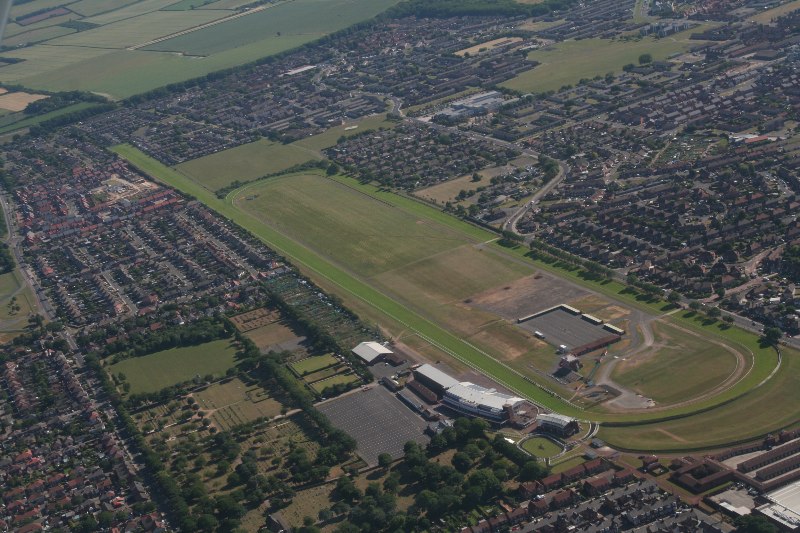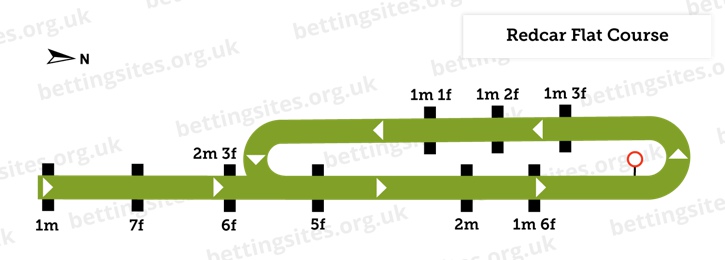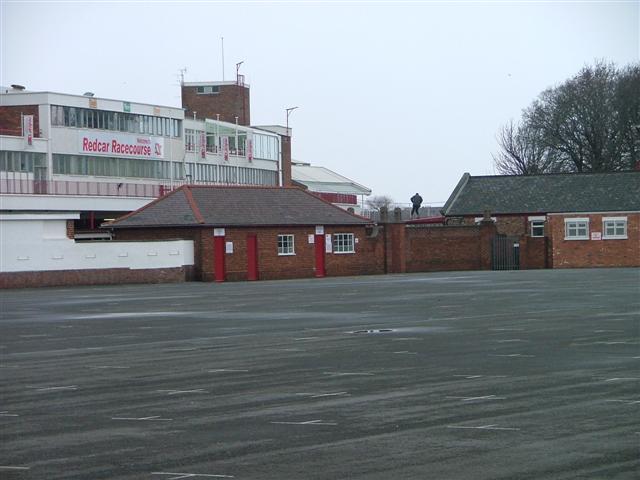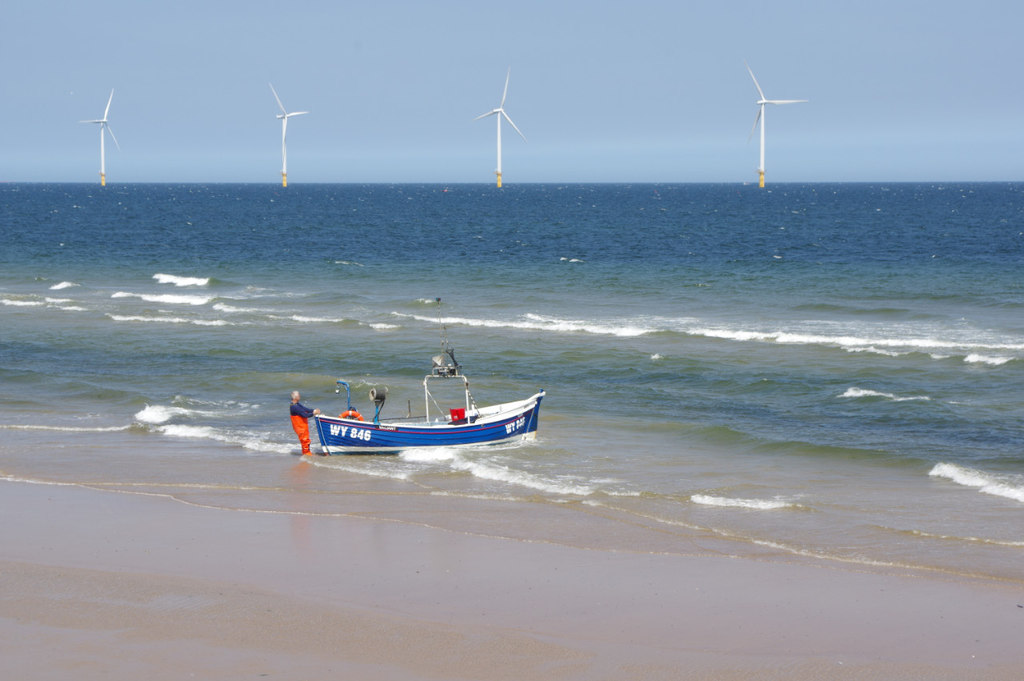Redcar Racecourse Guide

The easily accessible Redcar Racecourse takes up 72 acres of land right in the heart of the Tees Valley town. There is a beach close by and plenty of other nearby attractions to keep you entertained before and after the thrill of the racing.
Redcar is set up to accommodate all types of racegoers and even promotes itself a place for hen and stag parties. It hosts 18 days of action from March through to November, all of it taking place on a flat course.
Jump to: Course | Races | Useful Info | History
Map
The Course

Redcar’s very long and narrow course is quite distinctive in shape and it allows it to host races up to one mile on a straight track. For races longer than that, horses will have to take on at least one of the very sharp bends, the bottom of which is particularly tricky. There are a few ridges for jockeys to worry about too but overall Redcar offers a fair test and one that can often ride fast.
With it having such a long and straight run-in, timing the final push can really make the difference here. The lead regularly changes hands many times during the final stages despite the course being perfectly flat. Those who are patient and leave it late tend to fare better than the rest.
Major Races
The Zetland Gold Cup is the big race during the first half of the season. Featuring in late May or early June, the one mile and two furlong Class 2 handicap is a well-attended and frequently competitive contest. During the second half, one of the major races is October’s Guisborough Stakes, a seven furlong race of Listed quality that is open to horses three and above.
October also sees the Two-Year-Old Trophy which is the most lucrative race of the season at Redcar. Fields are usually in excess of 20 runners and it takes a special effort to be the first across the line in this six furlong contest. There have been some talented winners in the past such as July Cup winner Limato, who won this race in 2014 and Somnus, winner of the 2003 renewal, who was crowned European Champion Sprinter the following year.
Visiting

Redcar organises its meetings on a wide selection of days, with at least one meeting on every day of the week over the annual calendar.
Useful Info
Dress Code
While there are no formal rules surrounding dress at Redcar, anyone in the Grandstand Enclosure is encouraged to wear smart casual attire. Anybody wearing sports clothing or who is deemed too untidy, may be refused entry to the enclosure.
Ticket Prices
All admission tickets purchased before 1st March will receive a £1 early bird discount, all tickets bought after this date including on the day will be charged at full price. Full price tickets for standard racedays cost £5 in the Course Enclosure and £13 in the Grandstand Enclosure, for premier racedays prices increase to £6 and £16, respectively.
Students and OAPs receive a £3 discount in the Grandstand Enclosure and £1 discount in the Course Enclosure when purchased at the gate. Children aged 17 and under are admitted free with a paying adult.
Membership
Annual badges cost £155 at Redcar or £165 if bought after 1st March. There are around 40 reciprocal meets members can attend as well as 11 Yorkshire Country Cricket matches. You’ll also have use of the Paddock Stand Bar along with owners and trainers and access to an exclusive viewing box.
Getting There
Any car drivers are warned to arrive in plenty of time as there can be a lot of traffic by the course before the first race. Redcar Central rail station, which has links to Newcastle, Middlesbrough and Darlington is just a seven minute walk away but there will be taxis outside if you don’t fancy the stroll.
Parking
There is plenty of free on-site parking available every raceday.
History

Racing in the area originally took place on the beaches of Redcar with just a handful of contests being organised on an infrequent basis. Facilities and prizes were modest and the grandstand that offered some shelter was only a temporary one built by local joiner, Mr Adamson, who charged for its use. In return for being allowed to charge spectators, Mr Adamson had to set up the winning and start post plus a judge’s box. Those were the days!
When Jockey Club rules were introduced, money had to be raised from admission fees so racing had to move from the beach, with the last race taking place there in 1870. The new course was built with hurdles and an accompanying parade ring. Clerk of the Course, Thomas Dawson, was responsible for drainage, levelling the course and returfing where required. The new track officially opened its doors on August 9th 1872. That makes Redcar’s current home five year’s younger than modern Canada!
Grandstands
The new course began without a grandstand but in 1875, the building of a permanent Grandstand and Stewards’ Stand was completed at a cost of £2,650. A second stand would follow in 1877 and then on-site stables the year after to stop horses having to travel in on the day of the race. The changes impressed a racing correspondent from Bailey’s Magazine whose positivity towards the course helped put it on the racing map.
World War Impact
Racing was put on hold during both world wars as the course was used both for flight training and as an army camp. The state of the course was neglected during the Second World War and Major Leslie Petch had a real job on his hands to improve things when he was appointed manager in 1946. Petch, alongside a team of hardworking staff worked tirelessly to improve the track and they also made Redcar the first course to have CCTV, a timing clock and furlong posts. For a relatively small track, Redcar is certainly rich in history.
Renovations
A huge increase in popularity that followed forced Redcar to upgrade its facilities once again. In order to provide a great deal more shelter, a new grandstand was built in 1964 and it is still in use today. Petch retired in 1971 and regarded turning around the fortunes of the once insignificant and derelict course as his greatest achievement. With its decent facilities, friendly atmosphere and beachside location, Redcar certainly makes for a fun day out and is worth a visit for sure.

